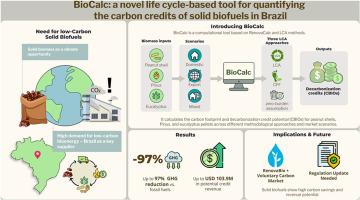BioCalc: a novel life cycle-based tool for quantifying the carbon credits of solid biofuels in Brazil
IF 5.8
2区 生物学
Q1 AGRICULTURAL ENGINEERING
引用次数: 0
Abstract
The increasing global demand for low-carbon energy sources has intensified interest in solid biofuels, such as pellets, particularly in regions with abundant biomass availability like Latin America. However, methodological and regulatory challenges persist in assessing their carbon footprint and integrating them into carbon credit schemes. This study presents BioCalc, a novel computational tool adapted from the Brazilian RenovaCalc model to quantify the carbon intensity of solid biofuels under a Life Cycle Assessment (LCA) framework. The tool incorporates harmonized emission factors, land use change modeling, and cradle-to-grave system boundaries to enable robust assessments. Three biomass sources—peanut shell, Pinus, and Eucalyptus—were analyzed across domestic, export, and mixed market scenarios. BioCalc calculated carbon intensity and potential decarbonization credits (CBIOs) using three LCA approaches: standard attributional LCA, Circular Footprint Formula (CFF), and zero-burden assumption. Results revealed substantial emission reductions—up to 97 % compared to fossil fuels—and highlighted methodological sensitivities in credit quantification, with CFF yielding the highest economic potential. National production forecasts were evaluated, projecting up to USD 103.9 million in revenues under specific conditions. This research provides a policy-aligned, science-based pathway for integrating solid biofuels into regulated and voluntary carbon markets. It strengthens the case for regulatory updates to include densified biomass fuels in Brazil's decarbonization strategies and offers a replicable model for advancing circular bioeconomy principles in the global energy transition.

BioCalc:一个新的基于生命周期的工具,用于量化巴西固体生物燃料的碳信用额
全球对低碳能源的需求不断增长,增强了人们对固体生物燃料(如颗粒)的兴趣,特别是在拉丁美洲等生物质资源丰富的地区。然而,在评估它们的碳足迹并将其纳入碳信用计划方面,方法和监管方面的挑战仍然存在。本研究提出了一种新的计算工具BioCalc,它改编自巴西的RenovaCalc模型,用于在生命周期评估(LCA)框架下量化固体生物燃料的碳强度。该工具结合了统一的排放因子、土地利用变化建模和从摇篮到坟墓的系统边界,以实现可靠的评估。花生壳、松木和桉树三种生物质资源分别在国内、出口和混合市场情景下进行了分析。BioCalc使用三种LCA方法计算碳强度和潜在脱碳信用(CBIOs):标准归因LCA、循环足迹公式(CFF)和零负担假设。结果显示,与化石燃料相比,碳排放减少了97%,并强调了信用量化方法的敏感性,其中CFF产生了最高的经济潜力。对国家生产预测进行了评估,预计在特定条件下的收入可达1.039亿美元。这项研究为将固体生物燃料纳入受监管和自愿的碳市场提供了一条与政策一致、基于科学的途径。它加强了监管更新的理由,将致密生物质燃料纳入巴西的脱碳战略,并为在全球能源转型中推进循环生物经济原则提供了一个可复制的模式。
本文章由计算机程序翻译,如有差异,请以英文原文为准。
求助全文
约1分钟内获得全文
求助全文
来源期刊

Biomass & Bioenergy
工程技术-能源与燃料
CiteScore
11.50
自引率
3.30%
发文量
258
审稿时长
60 days
期刊介绍:
Biomass & Bioenergy is an international journal publishing original research papers and short communications, review articles and case studies on biological resources, chemical and biological processes, and biomass products for new renewable sources of energy and materials.
The scope of the journal extends to the environmental, management and economic aspects of biomass and bioenergy.
Key areas covered by the journal:
• Biomass: sources, energy crop production processes, genetic improvements, composition. Please note that research on these biomass subjects must be linked directly to bioenergy generation.
• Biological Residues: residues/rests from agricultural production, forestry and plantations (palm, sugar etc), processing industries, and municipal sources (MSW). Papers on the use of biomass residues through innovative processes/technological novelty and/or consideration of feedstock/system sustainability (or unsustainability) are welcomed. However waste treatment processes and pollution control or mitigation which are only tangentially related to bioenergy are not in the scope of the journal, as they are more suited to publications in the environmental arena. Papers that describe conventional waste streams (ie well described in existing literature) that do not empirically address ''new'' added value from the process are not suitable for submission to the journal.
• Bioenergy Processes: fermentations, thermochemical conversions, liquid and gaseous fuels, and petrochemical substitutes
• Bioenergy Utilization: direct combustion, gasification, electricity production, chemical processes, and by-product remediation
• Biomass and the Environment: carbon cycle, the net energy efficiency of bioenergy systems, assessment of sustainability, and biodiversity issues.
 求助内容:
求助内容: 应助结果提醒方式:
应助结果提醒方式:


